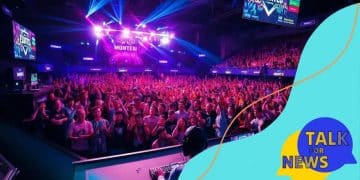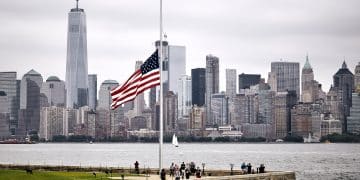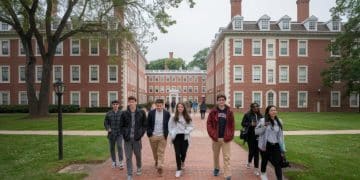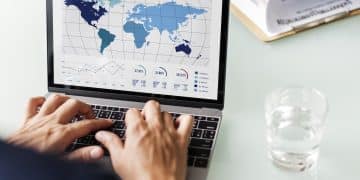The role of AI in transforming the creative industries
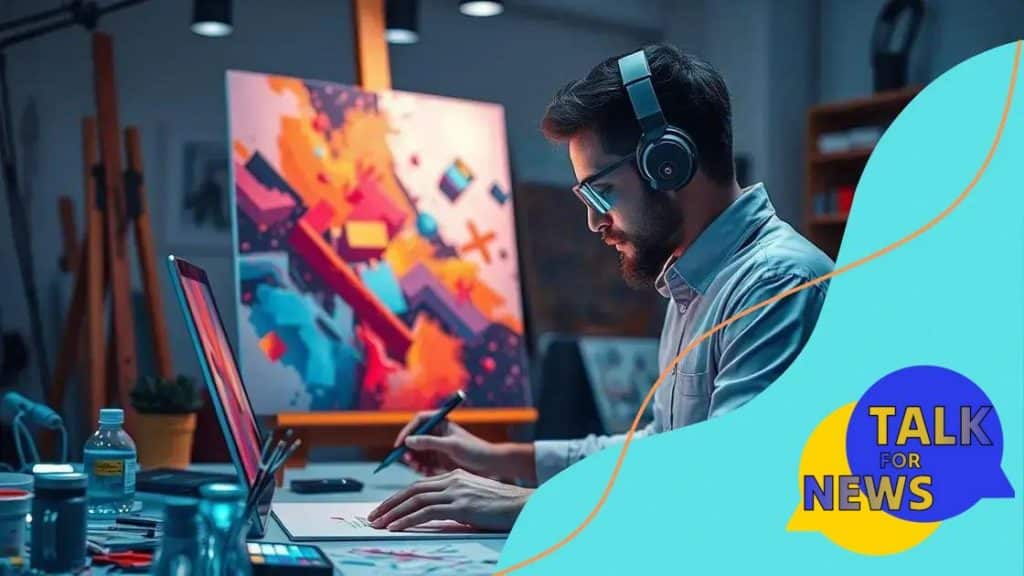
Anúncios
The role of AI in transforming the creative industries involves enhancing creativity, streamlining processes, and fostering collaboration between artists and technology, ultimately reshaping how art is created and experienced.
The role of AI in transforming the creative industries is becoming more significant as technology evolves. Have you ever wondered how AI can enhance your artistic process or reimagine storytelling?
Anúncios
Understanding AI’s influence on creativity
Understanding how AI influences creativity helps us appreciate the changes in artistic expression. Artists and creators are increasingly using AI tools to enhance their work and push boundaries.
One way AI impacts creativity is through the development of new tools that make creative processes easier. For example, artists now have access to software that can generate ideas or even create art pieces based on inputs they provide. This allows for greater experimentation and innovation.
Key Benefits of AI in Creative Fields
Anúncios
AI brings several advantages to artists, including:
- Enhancing productivity by automating repetitive tasks.
- Offering insights and suggestions that can inspire artists.
- Enabling collaboration between humans and machines, creating unique art.
- Providing accessibility to art creation for those without traditional skills.
Moreover, AI’s role is not just about efficiency. It can uncover new art forms and styles. As creators collaborate with AI, they can explore music, visual arts, and writing in ways previously unimaginable. This creates a dialog between technology and human expression.
Examples of AI Tools Transforming Creativity
There are numerous AI applications that are transforming the creative landscape. For instance:
- DeepArt: It uses neural networks to apply artistic styles to photos.
- OpenAI’s DALL-E: This AI can generate visual imagery based on textual descriptions.
- AIVA: An AI that composes music, allowing musicians to explore new compositions.
AI also allows for a deeper engagement with audiences. By analyzing user preferences, artists can tailor their work to resonate more effectively with viewers. This interaction leads to more meaningful experiences and connections.
As we continue to explore AI’s influence on creativity, it becomes evident that it can be both a tool and a partner in the artistic process. It enables artists to embrace new concepts while maintaining their unique vision. This synergy fosters a vibrant and evolving creative landscape, paving the way for future innovations.
Innovative tools powered by AI
Innovative tools powered by AI are changing the landscape of creativity today. These tools offer exciting possibilities for artists, designers, and writers to enhance their work and express their ideas.
Among the most notable innovations are applications that assist in generating content or designs. For example, AI can analyze millions of artworks to suggest unique styles or color palettes. This means that artists and designers can experiment without the fear of being stuck in a creative rut.
Popular AI Tools Enhancing Creativity
Here are some of the most popular AI tools that are making waves in the creative industries:
- Canva’s Magic Write: This tool helps users create graphics by suggesting designs and layouts.
- Adobe Sensei: It uses AI to automate tedious tasks, allowing designers to focus on creativity.
- Runway ML: A platform that offers creative video editing tools powered by machine learning.
- DALL-E: An AI that generates images from text descriptions, opening new avenues for visual storytelling.
These AI-powered tools are designed to complement human creativity, not replace it. They analyze user input and provide suggestions that can lead to unexpected and inspiring results. This collaboration between human and machine can result in groundbreaking art that blends traditional techniques with modern technology.
Moreover, these tools often come equipped with features that allow personalization. Users can customize settings according to their preferences, making the creative process more tailored and unique. By doing so, artists can maintain their individual style while benefiting from the efficiency of AI.
Real-World Applications of AI in Creativity
A variety of industries have embraced these innovative tools. In the fashion industry, designers use AI to predict trends and create new styles quickly. In the film industry, AI can optimize editing processes and even assist in scriptwriting. Writers benefit from AI-powered grammar and style checkers, which improve the quality and flow of their content.
The role of AI tools in enhancing creativity is becoming increasingly vital. As technology advances, we can expect even more exciting developments that challenge our understanding of what it means to be creative in a digital age.
Case studies of AI in creative projects
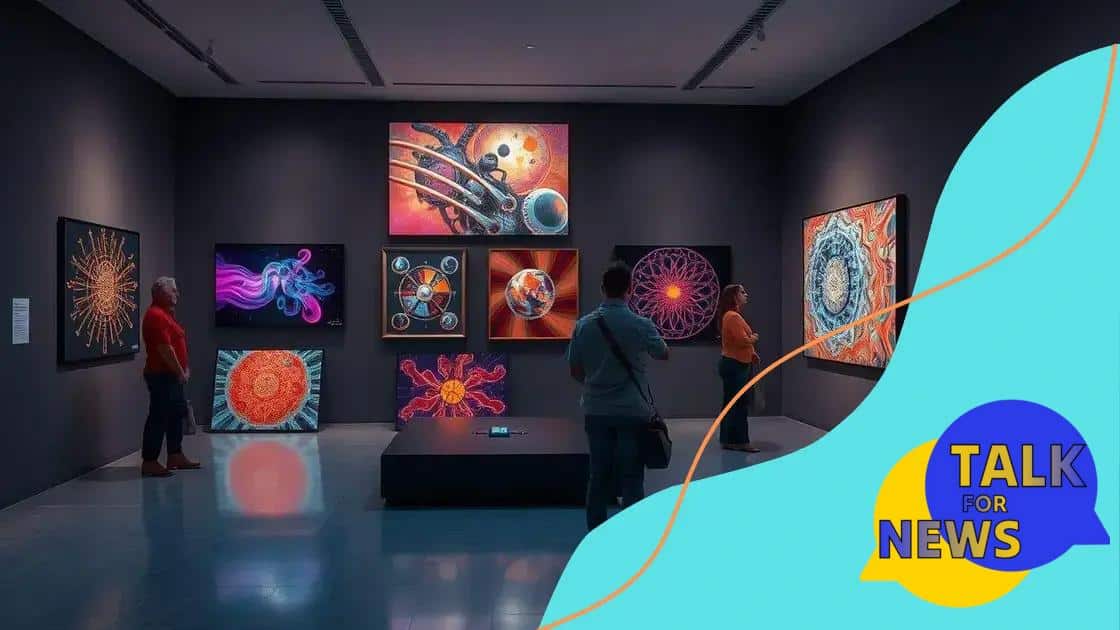
Case studies of AI in creative projects highlight the innovative ways artists and organizations are using technology to transform their work. These real-world examples showcase how AI is driving new forms of creativity, pushing boundaries in various fields.
For instance, the AI-generated artwork created by Refik Anadol is a great example of this trend. He uses machine learning algorithms to analyze large datasets of images and create stunning visual displays. His installations have transformed spaces, such as museums, showcasing how AI can be a co-creator in the artistic process.
Notable Case Studies
Several projects stand out as benchmarks for the successful integration of AI into creative initiatives:
- Obvious Art: This collective gained fame when their AI-generated portrait “Edmond de Belamy” was auctioned at Christie’s for a significant sum, raising questions about authorship and creativity.
- AIVA: This AI composer creates original music for films and video games. By analyzing existing compositions, AIVA learns styles and produces compositions that resonate with human emotions.
- Google’s DeepDream: Originally created for image recognition, this project allows artists to manipulate visuals, resulting in dream-like images that are both unique and surreal.
Additionally, AI is being used in advertising and marketing. Companies are leveraging AI analytics to create personalized content, optimizing campaigns according to audience preferences. This not only enhances user engagement but also reduces the time spent on content creation.
The collaboration between humans and machines in these case studies showcases a new paradigm in creativity. Artists are not merely using AI as a tool; they are exploring new definitions of creativity, testing the limits of their art. As these projects exemplify, AI opens doors to possibilities previously thought unattainable.
Balancing human creativity with AI
Balancing human creativity with AI is essential in today’s artistic landscape. As we embrace technology in our creative processes, it is important to maintain the unique perspectives and emotions that humans bring to art.
One significant aspect of this balance is understanding how AI can serve as a tool rather than a replacement for human creativity. AI can assist artists by providing suggestions or generating ideas, but the final decisions should always rest with the creator. This collaboration allows artists to explore new avenues while ensuring their personal touch remains evident.
The Role of AI in Creative Processes
AI can streamline many tasks, allowing creators to focus more on their vision. Here are some ways AI provides support:
- Idea Generation: Artists can use AI algorithms to brainstorm concepts or themes.
- Automating Repetitive Tasks: Functions like editing and color correction can be automated, saving valuable time.
- Exploring New Styles: AI can introduce artists to styles and patterns they may not have considered before.
Despite these benefits, artists must also be cautious of over-reliance on technology. Using AI excessively can lead to a loss of originality and authenticity. It’s crucial to regularly engage in practices that help preserve the human element in creativity.
Furthermore, many artists are discovering ways to blend their personal experiences with AI-generated content. This fusion encourages innovation while honoring the creator’s story. By merging human input with AI-generated suggestions, artists can produce works that are not only original but also meaningful.
Finding the Right Balance
Finding the right balance between human creativity and AI involves open-mindedness and experimentation. Artists should continuously evaluate their process, considering where AI enhances their work and where it might hinder their unique voice.
In addition, engaging with fellow creatives and sharing experiences can help in finding this balance. Collaboration can lead to new insights about utilizing AI without losing the essence of creativity. As the relationship between human creativity and AI evolves, it holds the potential to reshape the artistic landscape, fostering an environment where both can thrive together.
Future trends in AI and the creative sector
Future trends in AI and the creative sector are shaping how artists and creators will work in years to come. As technology advances, we can expect even more innovative ways to merge creativity with artificial intelligence.
One key trend is the rise of collaborative AI. This means artists will not just use AI as a tool but will engage in partnerships with AI systems that can learn and grow alongside them. This collaboration can enhance the creative process, allowing for more personalized and unique works.
AI in Content Creation
Another significant trend is how AI will change content creation. As AI becomes more adept at understanding context and emotion, we can anticipate AI-generated content that resonates deeply with audiences. Here are some examples of potential advancements:
- Real-time Creativity: Instantaneous creation of art or music based on user preferences.
- Interactive Experiences: AI can create tailored experiences for audiences, enhancing engagement.
- AI-assisted Storytelling: Writers may use AI to develop plotlines or character traits more efficiently.
Moreover, AI’s ability to analyze data can lead to more effective marketing strategies in the creative industry. By understanding audience habits and preferences, creators can produce targeted content that speaks directly to their audience’s interests.
Sustainability and Accessibility
As the creative sector evolves, trends will likely emphasize sustainability and accessibility. AI can help reduce waste in artistic production, making it easier for creators to adopt eco-friendly methods. Additionally, AI tools can democratize art by providing access to creative resources for individuals who may not have traditional training.
Finally, we can expect a growing interest in ethical considerations surrounding AI in the creative sector. Discussions about copyright, authorship, and the moral implications of AI-generated art will be crucial as technology continues to integrate into the creative landscape.
Overall, the future of AI in creative industries looks promising. By effectively balancing technology and human intuition, artists will be able to explore exciting new avenues in their work.
FAQ – Frequently Asked Questions about AI in the Creative Industries
How is AI changing the creative landscape?
AI is transforming creativity by serving as a collaborative tool, helping artists generate ideas and streamline processes.
What are the potential risks of using AI in art?
Over-reliance on AI might lead to a loss of originality, making it essential for artists to maintain their unique voice.
Can AI make art more accessible?
Yes, AI tools can democratize art creation by providing resources and learning opportunities to individuals without formal training.
What is the importance of ethical considerations in AI-generated art?
Ethical discussions around copyright and authorship are crucial as AI becomes more integrated into the creative process.
